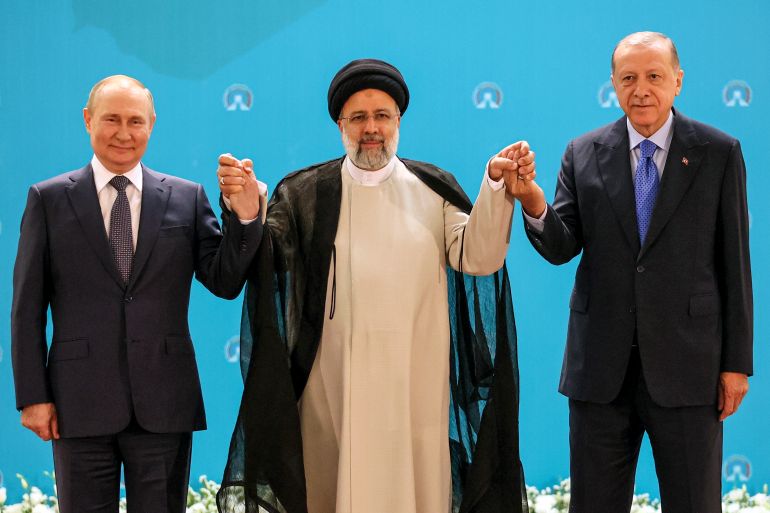Middle East politics: From hyper to hybrid
The hyper-strategic alliances that defined the region during the Cold War now appear to be turning hybrid, fluid, pragmatic and unpredictable.

As a new type of Cold War came to dominate American-Russian relations after the latter’s invasion of Ukraine, major Middle Eastern players are maintaining a distance, refusing to take sides.
It is a sign that the hyper-strategic alliances that polarised the region, and the world, during the old Cold War are turning hybrid, fluid, pragmatic and unpredictable.
During the old Cold War, the Middle East was characterised by greater foreign intervention and relatively more frequent high-intensity conflicts.
The post-Cold War was even worse for the ill-fated Middle East – in the past 20 years, it featured most of the world’s deadliest conflicts. But as the wars in Syria, Yemen and Libya wind down; as regional conflicts reach dead ends, and regional and global powers show signs of faintness and fatigue, a new geopolitical environment is now taking shape.
This new dynamic was demonstrated clearly during the recent American-Arab summit in Jeddah and the trilateral summit between Russia, Iran and Turkey in Tehran.
Last week’s summit in Jeddah exposed the divergence and distrust between the US and its partners/clients in the Middle East. President Joe Biden tried to convince them to increase oil production and cease all cooperation with Moscow, to no avail. Despite Washington’s pleas and pressures, Saudi Arabia, the United Arab Emirates and Egypt gave no sign that they may stop dealing with Moscow on energy and trade any time soon. This is a far cry from the 1980s, when Saudi Arabia enlisted on Washington’s side in the Cold War, helping to dislodge the Soviet forces out of Afghanistan, and pushing down the price of oil under American pressure.
During his first trip to the region as president, Biden, who had only recently railed against the “pariah” regimes that rule in the Middle East, swallowed his tongue and pride at the service of the “national interest”. Yet, Riyadh and Cairo rejected US dictates and even questioned its strategic competency and staying power, considering its humiliating withdrawal from Iraq and Afghanistan and its erratic behaviour over the past two decades.
America’s relative decline, amid China’s rise and Russia’s resurgence, has prompted its allies to pursue hybrid, non-exclusive foreign relations based solely on their national and regime interests. It is as if Israel’s chutzpah has finally rubbed off on its neighbours, friends and foes alike. Like Tel Aviv, important Middle Eastern players want American arms and American aid but not America’s advice.
Despite being Washington’s closest regional ally and the first stop on President Biden’s Middle East trip, Israel has also refused to acquiesce to US wishes on not only Russia but also Iran and Palestine. In fact, Israel, which has taken the tail-wagging-the-dog dynamic to a whole new level, yet again treated America like no more than a dumb puppy.
Like Israel, Saudi Arabia and its regional allies, Turkey, which straddles east and west, geographically and geopolitically, has gone hybrid for some time now.
In this week’s trilateral summit in Tehran, this major NATO member has reached new agreements with Washington’s strategic foes, Iran and Russia; even proposing arms sales to the ayatollahs.
After NATO allies refused to sell it air defence systems on acceptable terms, Turkey turned to NATO’s foe, Russia, to purchase its sophisticated S-400 system, to Washington’s utter dismay. Since then, Saudi Arabia has shown similar defiance, initiating talks with Moscow to purchase the Russian system.
And like Turkey, Israel and Saudi Arabia, Iran is also trying to pursue hybrid relationships, allying itself with China and Russia while remaining open to collaboration with Europe and insisting on negotiating a return to the Nuclear Deal with the United States. And since its invasion of Ukraine, Russia has become more dependent on Iran to counterbalance American and Turkish influences in Syria.
Meanwhile, these central Middle Eastern players are pursuing hybrid relations within the region as well as beyond it. Iran and Saudi Arabia may be arch enemies, stuck in a Cold War logic of sort, but they are also involved in direct diplomatic talks aimed at reducing tensions in the Gulf and finding accommodations on regional hotspots, like Yemen, Iraq, Syria and Lebanon, etc.
Similar dynamics emerged between UAE and Iran, as the UAE normalised relations with the Assad regime in Syria and sort of pulled out of the Yemen war, while at the same time establishing diplomatic, security and strategic relations with Iran’s arch enemy, Israel.
In short, the new hybrid geopolitical dynamics look nothing like the rigid and hyper bi-polarity that divided and dominated the world for decades. Since the world fights wars as it makes business and as it does politics, using similar tools and methods, this shift will likely prove lasting and global. In other words, and at the risk of oversimplification, expect more governments to pursue hybrid policies in an increasingly hybrid environment characterised by hybrid work, hybrid cars and hybrid warfare. This will further complicate the global and regional dynamics, producing a dizzyingly changing reality, making it ever harder to predict what might come next; where a new explosion might occur, or whether certain countries might reach accommodation tomorrow.
All of this begs the question: Will the shift from hyper to hybrid relations bring stability; or even peace to the Middle East? It might indeed reduce inter and intra-national instability for some time, but unless and until regional actors use that window to address the urgent questions of justice and human rights, expect more of the same instability and violence.
